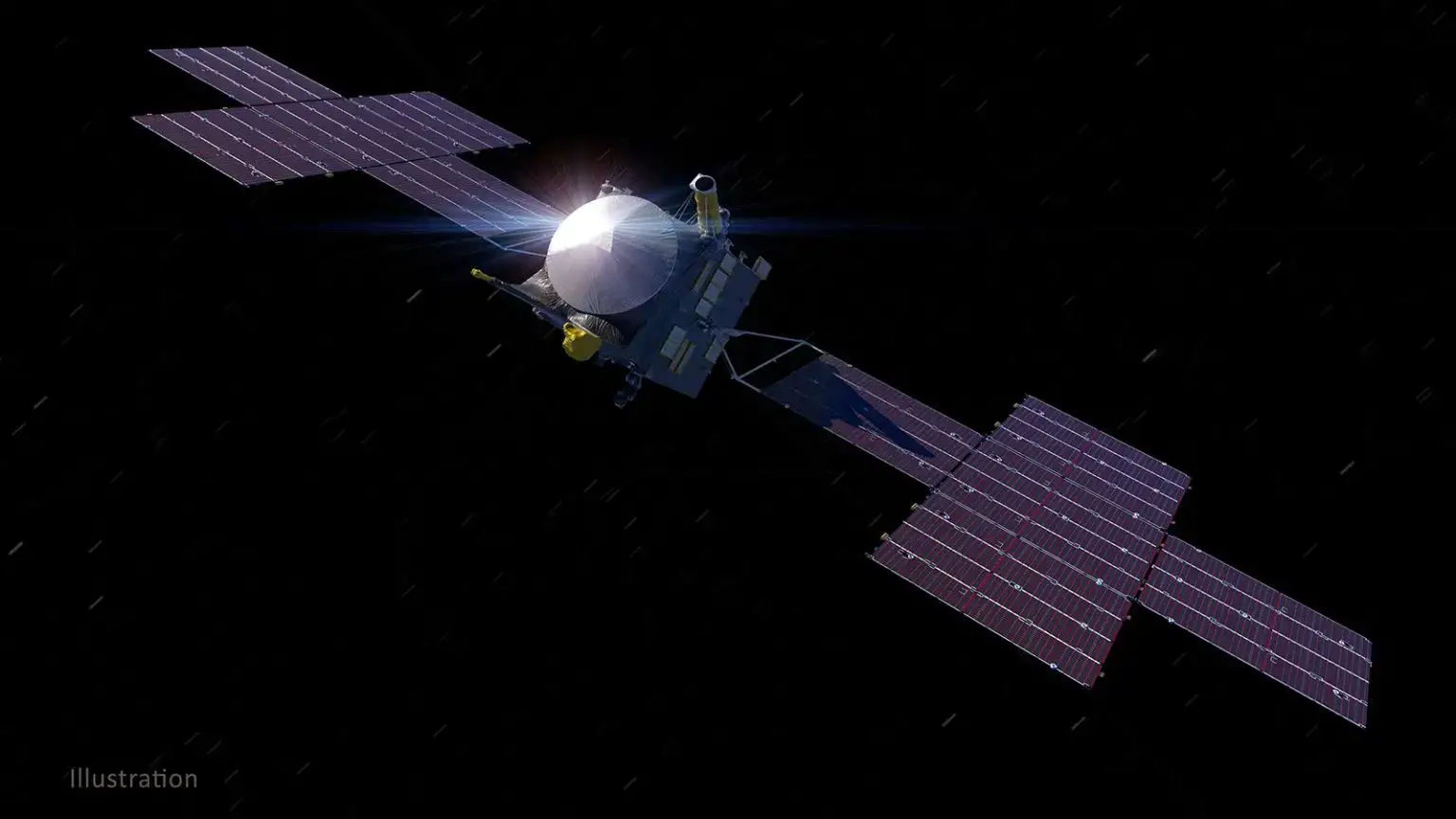On the way there, the spacecraft will receive a gravitational push from Mars. It is expected to reach the orbit around the asteroid in the first stage in June 2029

NASA's Psyche spacecraft began its journey towards asteroid Psyche after successfully launching aboard SpaceX's Falcon 9 launcher on Friday 13/10/2. Psyche is considered the exposed core of a planet orbiting in the asteroid belt. Through this mission, NASA aims to learn about the composition of the asteroid with the help of advanced scientific instruments, and provide insights into the early stages of planet formation and the evolution of the solar system.
The Psyche spacecraft successfully activated the electric propulsion powered by solar energy. During its six-year journey, it will use advanced optical communications using NASA's DSOC and is expected to enter orbit around the asteroid by 2029.
Psyche's mission controllers on Earth have received a full signal from the spacecraft, and the solar panels are fully assembled. The spacecraft will be powered by solar electric propulsion. The pentagonal cruciform solar panels provide about 800 square feet of solar collection area and give the spacecraft the size of a tennis court when fully deployed.
The solar panels will produce more than 20 kilowatts of power when the spacecraft is close to Earth, but they will produce just over 2 kilowatts of power – only slightly more power than a hair dryer – when they reach asteroid Psyche, which is very far from the sun. However, this will be more than enough power for the spacecraft's needs on its journey, including powering scientific instruments, communications, equipment that controls the spacecraft's temperature, and the spacecraft's highly efficient solar-electric propulsion engines.
At the start of its approximately 6-year journey, the Psyche spacecraft will spend about 100 days in initial health checks to make sure everything is working properly, before turning on its propulsion engines. About 2.5 years after launch, the spacecraft will fly by Mars for a gravitational push. About 5.5 years from now, the cruise period will end, and around June 2029, the cameras on the spacecraft will be able to take pictures of the asteroid Psyche. In August 2029, the spacecraft will enter a 26-month period of orbiting the metal-rich asteroid.
NASA's Deep Space Optical Communications (DSOC) demonstration, carried by the Psyche spacecraft, will send and receive probe data using an infrared invisible laser, which can transmit data at a bandwidth 10 to 100 times greater than conventional radio wave systems currently used by spacecraft. . DSOC will demonstrate operations for nearly two years after the launch of NASA's Psyche mission while en route to its 2026 Mars rendezvous.
Mission Psyche is led by Arizona State University. NASA's Jet Propulsion Laboratory is responsible for mission management, operations and navigation. NASA's Launch Services Program, located at the Kennedy Space Center, is responsible for the understanding and approval of the Space Launcher and manages the launch service for the Psyche mission. LSP certified SpaceX's Falcon Heavy Launcher for use with the agency's highest-priority and complex missions in early 2023 at the end of a 2.5-year effort.
NASA's Psyche spacecraft has begun its journey towards asteroid Psyche, which is believed to be the exposed core of a planet in the asteroid belt. Through this mission, NASA aims to learn about the composition of the asteroid with the help of advanced scientific instruments, and provide insights into the early stages of planet formation and the evolution of the solar system.
The Psyche spacecraft, on its way to the Psyche asteroid, successfully activated the electric propulsion powered by solar energy. During its six-year journey, it will use advanced optical communications using NASA's DSOC and is expected to enter orbit around the asteroid by 2029.
Psyche's mission controllers on Earth have received a full signal from the spacecraft, and the solar panels are fully assembled. The spacecraft will be powered by solar electric propulsion. The pentagonal cruciform solar panels provide about 800 square feet of solar collection area and make the spacecraft the size of a single tennis court when fully deployed.
The solar panels will produce more than 20 kilowatts of power when the spacecraft is close to Earth, but only a little more than 2 kilowatts of power – just a little more than the power of a hair dryer – when it reaches asteroid Psyche, which is very far from the sun. However, this will be more than enough power for the spacecraft's needs on its journey, including powering scientific instruments, communications, equipment that controls the spacecraft's temperature, and the spacecraft's highly efficient solar-electric propulsion engines.
At the start of its approximately 6-year journey, the Psyche spacecraft will spend about 100 days in initial health checks to make sure everything is working properly, before turning on its propulsion engines. About 2.5 years after launch, the spacecraft will fly by Mars for a gravitational push. About 5.5 years from now, the cruise period will end, and around June 2029, the cameras on the spacecraft will be able to take pictures of the asteroid Psyche. In August 2029, the spacecraft will enter the first 26-month period of the planned orbits around the metal-rich asteroid.
NASA's Deep Space Optical Communications (DSOC) demonstration, carried by the Psyche spacecraft, will send and receive probe data using an infrared invisible laser, which can transmit data at a bandwidth 10 to 100 times greater than conventional radio wave systems currently used by spacecraft. . DSOC will demonstrate operations for nearly two years after the launch of NASA's Psyche mission while en route to its 2026 Mars rendezvous.
Mission Psyche is led by Arizona State University. NASA's Jet Propulsion Laboratory is responsible for mission management, operations and navigation. NASA's Launch Services Program, located at the Kennedy Space Center, is responsible for the understanding and approval of the Space Launcher and manages the launch service for the Psyche mission, which is done as specified using SpaceX launchers.
More of the topic in Hayadan:
